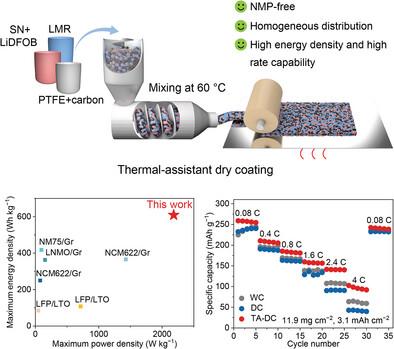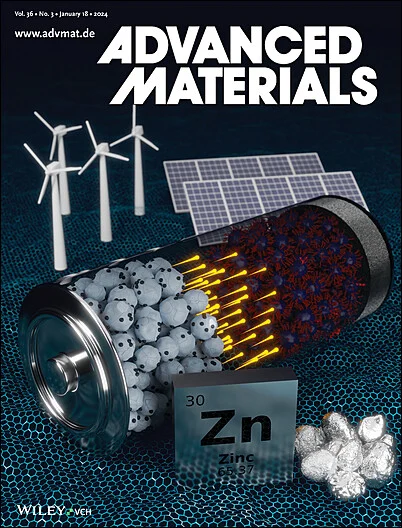Thermal‐Assisted Dry Coating Electrode Unlocking Sustainable and High‐Performance Batteries
IF 27.4
1区 材料科学
Q1 CHEMISTRY, MULTIDISCIPLINARY
引用次数: 0
Abstract
Current battery production relies on the use of large amounts of N‐methyl‐2‐pyrrolidnone (NMP) solvent during electrode preparation, which raises serious concerns in material cost, energy consumption, and toxicity, thus demanding the innovation of dry electrodes with excellent performance. However, state‐of‐the‐art dry electrodes show inferior energy densities, particularly under high‐areal‐capacity and fast charge/discharge conditions required for practical applications. Here dry production of high‐energy‐density Li‐ and Mn‐rich (LMR) cathodes is shown based on a thermal‐assistant approach. The lithium difluoro(oxalate)borate (LiDFOB) and succinonitrile (SN) serve as two key electrode mediators to facilitate Li

热辅助干涂层电极实现可持续的高性能电池
目前的电池生产依赖于在电极制备过程中使用大量的 N-甲基-2-吡咯烷酮(NMP)溶剂,这引起了人们对材料成本、能耗和毒性的严重关注,因此需要创新性能卓越的干电极。然而,最先进的干电极显示出较低的能量密度,尤其是在实际应用所需的高电容和快速充放电条件下。这里展示了基于热辅助方法的干法生产高能量密度富锂和富锰(LMR)阴极。二氟(草酸)硼酸锂(LiDFOB)和琥珀腈(SN)是促进 Li+ 运输的两种关键电极介质,熔化 SN-LiDFOB 的温和加热过程显著改善了电极中各种成分的分布。这些协同效应使干式 LMR 阴极的最大速率能力达到 4 C(12 mA cm-2),面积容量达到 11.0 mAh cm-2。根据阴极和阳极的总质量,由此产生的金属锂/LMR 全电池的最大能量密度和功率密度分别为 609 Wh kg-1 和 2,183 W kg-1。这些成果不仅突破了干电极能量密度的关键瓶颈,而且在更广阔的背景下,为绿色和可持续电池生产开辟了一条新途径。
本文章由计算机程序翻译,如有差异,请以英文原文为准。
求助全文
约1分钟内获得全文
求助全文
来源期刊

Advanced Materials
工程技术-材料科学:综合
CiteScore
43.00
自引率
4.10%
发文量
2182
审稿时长
2 months
期刊介绍:
Advanced Materials, one of the world's most prestigious journals and the foundation of the Advanced portfolio, is the home of choice for best-in-class materials science for more than 30 years. Following this fast-growing and interdisciplinary field, we are considering and publishing the most important discoveries on any and all materials from materials scientists, chemists, physicists, engineers as well as health and life scientists and bringing you the latest results and trends in modern materials-related research every week.
 求助内容:
求助内容: 应助结果提醒方式:
应助结果提醒方式:


